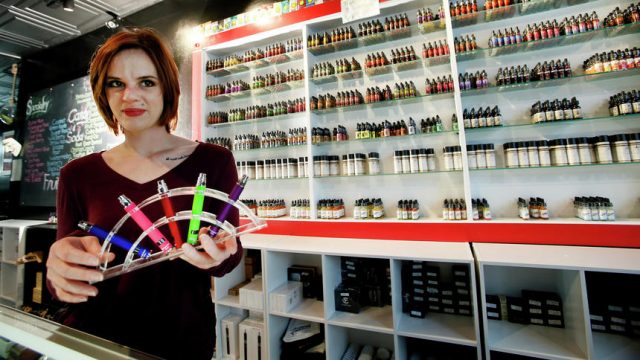Vaping Is Not the Same as Tobacco Use and Treating It That Way Would Be a Mistake

Kelsey Eaton, regional manager of Infinite Vapor located on Broadway in Fargo, shows a variety of e-cigarette devices with shelves full of vials with different flavors or scents and varying degrees of nicotine. Dave Wallis / The Forum
“Institutions will try to preserve the problem to which they are the solution.”
That saying is called the Shirky Principle, named for its originator writer Clay Shirky, and it’s what I think of when I hear the network of highly paid activists and government bureaucrats who make a living from anti-tobacco activism tell us that we must treat vaping (or e-cigarettes, to use their term) as though it were tobacco use.
It’s not tobacco use. Vaping is something else entirely. The goal is the same, in that both smoking and vaping are a way to deliver nicotine, but beyond that they are completely divergent. Thus the implications for public health are different.
Vaping, based on all of the information we have available to us now, is significantly healthier than smoking. Note that I’m not saying it’s healthy. It is not. But you would think those most interested in improving public health would be happy to embrace the improve represented by people vaping as opposed to smoking.
[mks_pullquote align=”left” width=”300″ size=”24″ bg_color=”#ffffff” txt_color=”#000000″]…despite the assumption that vaping will lead teens to smoking, the reality is that teen cigarette use hit a historic low in 2017.[/mks_pullquote]
Unfortunately, they are not. Because they are seemingly motivated by more pecuniary considerations. Their cushy jobs, which often come with six-figure paychecks, may be lost if the trend in declining tobacco use continues. Thus their interest in treating a new product, which is not tobacco, as though it were tobacco.
Today the Grand Forks Herald endorses that point of view, citing recent information from the FDA indicating “national e-cigarette use among high-schoolers has jumped 75 percent.”
That number is a little misleading. As Jacob Sullum, writing for Reason, notes: “According to the National Youth Tobacco Survey (NYTS), the share of high school students who reported vaping during the previous month peaked at 16 percent in 2015, fell to about 11 percent in 2016 and remained roughly the same last year.”
Meanwhile, despite the assumption that vaping will lead teens to smoking, the reality is that teen cigarette use hit a historic low in 2017.
While I’ll not say that it’s a good thing that teenagers are vaping – as a parent I am against my kids doing it – we should acknowledge that a switch from teen smoking to teen vaping is a net gain for public health.
One that could be lost if the anti-tobacco professionals get their way and the government begins treating vaping as though it were no different from tobacco. If vaping gets taxed the same way tobacco is here in North Dakota and in other states, if restrictions on supposedly kid-friendly marketing ploys like flavors are restricted as they have been for tobacco, we remove some of the incentive those inclined to smoke (kids and adults alike) have to switch to vaping.
I don’t want kids to vape. I don’t want them to smoke either. If they’re going to do one, I’d rather it be the former. And as far as adults go, if things like flavor and relatively lower taxes can entice adults to stop smoking and start vaping, why wouldn’t we want this?
There may well be some areas where a certain level of regulation makes sense for vaping. But to lump vaping in with tobacco would be a mistake.




